READING, Pa. — From the outside, it’s not much to look at. A squat, boxy gray building on the outskirts of an industrial town.
Behind the unassuming facade lies a glittering home. It’s where humming sewing machines, hundreds of bolts of fabric and millions of crystals come together to create the look of this year’s U.S. Olympic gymnastics teams.
Step inside GK Elite’s headquarters, about 90 minutes northwest of Philadelphia, and you’ll be greeted by models in signature leotards—like the navy one with sparkly white sleeves that Suni Lee wore when she won all-around gold in Tokyo—and photos of Olympic medalists stretching from floor to ceiling. Peek into a conference room and you’ll find memorabilia ranging from Wheaties boxes signed by 2008 Olympic all-around champion Nastia Liukin to a “Time” cover autographed by Simone Biles.
It’s part museum, but it’s a manufacturing facility first and foremost. From the first design sketches to the final hand-set stones, it’s the birthplace of the dazzling leotards that Biles, Lee, Jordan Chiles, Jade Carey and Hezly Rivera will be wearing later this month.
On Wednesday, GK Elite unveiled the women’s team’s eight Olympic leotards, adorned with Swarovski crystals in a patriotic color palette. The wardrobe, which draws inspiration from American iconography, French art and even old Hollywood, is ultimately about more than just aesthetics. Gymnasts have long used leotards to add an extra layer of personality and boost their confidence on the competition floor. And each of the leotards they’ll be taking to Paris has its own story.
For Carey, seeing her Olympic outfit the day after the U.S. trials was an even more rewarding experience than making her first Olympic team. She earned a ticket to Tokyo as an individual athlete and won gold in floor exercise, but wasn’t part of the four-person team that won silver. In Paris, she’ll have a chance to help the U.S. win another team medal.
“I felt like the Olympic team was a reality for me. Everything happens so quickly after the trials, and seeing the leotards made me feel like it was official,” she said. “I was so excited to be able to wear them and proud to represent Team USA again.”
The process of manufacturing the leotards from a Pennsylvania factory to Paris began two years ago. GK design director Jeanne Diaz and her team — who also designed the U.S. looks for Tokyo 2021 — began compiling images from runway shows and art museums into mood boards to inspire 2022. They looked to Paris for ideas, but they also sought to create a wardrobe that was “undeniably Team USA,” Diaz said.
The leotard the gymnasts will wear for the team finals is the centerpiece. GK’s goal was to recreate the feeling of an athlete being draped in an American flag, an Olympic tradition that continues after a victory. The leotard features a navy sleeve covered in crystal-trimmed stars and a white bodice accented with red stripes. Most of the leotard’s 9,929 crystals are diamond-shaped.
“In track and field, you really think about it. In swimming and gymnastics, you really think about it. Just wrapping the flag around yourself after you get it from someone in the stands,” Diaz said. “It’s that really special, emotional moment that we wanted to capture in a leotard.”
The design also pays homage to the 1996 Games’ “Mercenary Seven,” the first U.S. women’s gymnastics team to win Olympic gold. To avoid simply recycling an old design, Diaz said GK focused on modernity.
“We took a graphic approach, kind of a digital version of the flag. We cut the lines in an organized way and really played with thick and thin lines to give the athlete a special moment where they can see all the really interesting details.”
For individual event qualifications and finals, gymnasts can choose from the other seven leotards.

From left to right: The American flag-themed look that will be worn during the team finals, the all-blue superhero-inspired style, and the grayscale star-centric design. (Courtesy of GK Elite)
For another version, GK designed a blue leotard covered in more than 10,000 crystals. Most of the stones are on the bodice, arranged in a shape that Diaz says is inspired by corsetry while evoking the look of a superhero’s armor. The dazzling stars and angular lines along the sleeves are an abstract interpretation of the stars and stripes of the American flag.
Another version stands out because it is the only Olympic leotard that is neither red, white nor blue. From a distance, it looks like a metallic gray leotard covered in large stars from the waist to the collar and along the sleeves. But upon closer inspection, the stars are revealed to be the negative space between multi-colored dots and garnet, periwinkle, turquoise and gold crystals. The dots are a nod to French artist Georges Seurat, who developed the painting technique known as pointillism. Velvet accents to accentuate the collar, waist and cross-back straps were added at the athletes’ suggestion.
While gymnasts can design their own outfits for national competitions like the U.S. championships, they typically have no say in the top-secret Olympic designs. The velvet request came from a survey GK sent to national team members, who said they liked the fabric but only in small quantities because it could be hot.

Three of the leotards draw inspiration from both the fleur-de-lis symbol, long associated with the French crown, and old Hollywood style. (Courtesy of GK Elite)
Another trio of leotards features curved lines and crystal motifs resembling the fleur-de-lis.
“This collection is very inspired by French haute couture and Art Nouveau. But it’s also inspired by the American glamour of 1920s Hollywood,” Diaz explains.
A solid white leotard with a caged bodice and intricate crystal pattern highlights this piece of the Olympic wardrobe with its delicate French lace-like sleeves and 970 white pearls interspersed with crystals. A lace-up design on the back adds a pop of color, as the crisscross straps are navy, brown and white.

Left: A blue leotard with colorful stripes reminiscent of fireworks. Right: An all-red version was created at the request of USA Gymnastics. (Courtesy of GK Elite)
USA Gymnastics specifically requested an all-red leotard, so Diaz’s team developed an asymmetrical design with mesh sleeves and a stretchy satin fabric that GK dyed especially for the Olympics, as well as a keyhole cutout in the back and a high collar. Rounding out the eight leotards is a dark blue number with mesh sleeves and a firework-like burst of crystals radiating from the right shoulder. Similar patriotic pyrotechnics are printed on the fabric.
Once USA Gymnastics gave the mock-ups the green light, production began in Reading with pattern creation, fabric selection and tailoring. Uniforms were custom-fitted to the gymnasts’ measurements, and GK produced 22 Olympic Collection ensembles to cover every member of the national team (plus a few extras, just in case).
In the factory, cut pieces of fabric were then sublimated with various prints and glued under an embroidery machine that quickly sewed two logos: a GK logo on the left hip and the USA logo on the right.
Across the room, a machine capable of placing up to 170 stones per minute was continuously fed with crystals. A small robotic arm retrieved the gems one by one from a pile and passed them to a smaller arm that printed them in detailed patterns on transfer paper. This paper was pressed onto the leotard pieces and fed into a heat transfer machine, which adhered the crystals to the fabric.
Additional stones were added using a laser system and a foot pedal operated by a GK employee who moved the fabric and tapped his foot when the red dot was in the right position for the next stone. Stones too large or delicate to be placed by a robot — like the large pearls on the all-white leotard — were placed by hand with tweezers. After quality checks, the leotards were ready for the sport’s biggest stage.
Each of them has the potential to become a symbol of Olympic glory, forever linked to a moment that will be broadcast around the world and etched in history.
Carey said: “I can’t wait for the world to see them.”

From left to right: Jade Carey, Suni Lee, Simone Biles, Jordan Chiles and Hezly Rivera show off the new leotards that will be worn in the team finals at the Olympics. (Courtesy of GK Elite)
(Top illustration of Simone Biles and Suni Lee in the new leotards: Dan Goldfarb / The Athletic; all images courtesy of GK Elite ; (video: Tess DeMeyer)